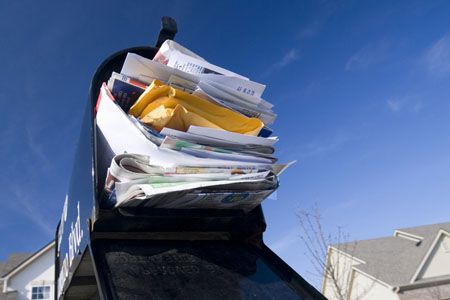Few people I know actually enjoy receiving junk mailings, whether they be in email inboxes or postal mail boxes. Over the years, I’ve managed to whittle down the amount of unsolicited postal mail that I receive to a few items a week, but have not been able to rid myself of it entirely. I still receive the odd credit card offer, clothing catalog, and coupon circular that I immediately deposit in my recycling bin. Wouldn’t it be great if I could just alert these companies to the fact that I never read their mailings, and that they should stop spending money printing and sending them to me?
Turns out that there is!
How to stop most* junk postal mail forever**, for free
*In practice for me, about 80%
** If you change addresses, you’ll need to to do this all over again
Upon recently educating myself about San Francisco’s recycling laws, I found a number of helpful tips and websites for alerting companies that you wish to stop receiving their junk postal mail. Here are a series of steps to follow:
- Opt-out of all sorts of catalogs and mailings at DMAChoice. This requires creating a username and password linked to your email address. Time spent: 5 minutes
- Prevent unsolicited credit card offers at Opt-Out PreScreen. This requires entering some personal details so that the big three credit bureaus (Equifax, TransUnion, and Experian) know that you are you. Time spent: 5 minutes
- Prevent yourself from receiving RedPlum coupon circulars at RedPlum’s website. Time: 5 minutes.
- Prevent yourself from receiving ValPack coupon circulars at Cox Target Media’s website. Time: 5 minutes.
- Prevent yourself from receiving PennySaver coupon circulars by writing to (must send them a letter) (time: 10 minutes)
- Harte-Hanks Direct Marketing
Attn: Consumer Preferences
c/o Pennysaver
2830 Orbiter Street
Brea, CA 92821
Phone: (800) 422-4116
- Harte-Hanks Direct Marketing
Total time spent: about 30 minutes!
Why do I get so much junk mail?
When you subscribe to many publications, place credit card orders, order items through the Internet (or through the mail!), join organizations, donate to charities, or enter sweepstakes, chances are that the fine print in the legaleze for interacting with these companies allows them to collect your personal information, and in many cases, share it with other companies for marketing purposes.
How effective is this, and when will I stop receiving junk mail?
While placing yourself on these “do not mail” lists can be instantaneous, having your junk mail disappear is not. Companies may take weeks to months to get updates from these lists and stop sending mailings. And, in many cases companies are not legally obligated to stop sending you mail – these “do no mail” lists are the industry’s “self-regulatory” answer to threats of legislation to regulate their activities. As self-regulation goes for these sorts of things, they typically work fairly well, but are not perfect. So I caution you to not expect all of your junk mail to disappear, nor for it to go away overnight.
Additionally, as mentioned above, often when transacting with companies (via purchasing their goods, donating to their causes, etc) you are giving the sender the OK to send you mail. Even after you stop receiving mail from a given sender, if you “re-engage” with them (by buying products, answering surveys, or donating) after they stop sending you things, it is often interpreted as your desire to start receiving their mailings again. Caveat emptor.
In practice, my junk mail decreased by about 80% of it’s volume, and within about 3 months. Your milage may vary.
Good luck!
